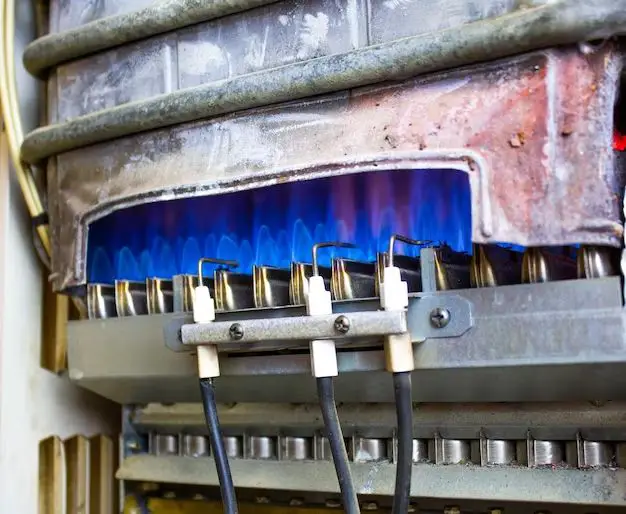A pilot tube, also known as a pilot light tube, is a small tube that is part of the ignition system for a gas water heater. The pilot tube is connected to the gas supply line and allows a small flame to burn constantly so that the main burner can be ignited when hot water is needed.
Page Contents
Purpose of the Pilot Tube
The pilot tube serves a few key purposes on a gas water heater:
- Provides a flame to ignite the main burner – When the thermostat calls for hot water, a valve opens allowing gas to flow to the main burner. The pilot light ignites this gas.
- Proves the heater is lit – The presence of the small pilot flame indicates the heater is currently lit and ready to heat water.
- Saves energy – Keeping a small flame going takes less energy than having to reignite the main burner every time hot water is needed.
Without a pilot tube, the water heater would require an electric ignition device to restart the main burner each time. The constant small pilot flame allows the main burner to restart quickly and easily when needed.
Pilot Tube Design
A typical pilot tube assembly consists of:
- Gas supply line – Provides gas to the pilot assembly from the main gas line.
- Adjustable gas valve – Controls gas flow specifically to the pilot light.
- Pilot tube – The small tube that transports gas to the pilot hood.
- Pilot hood – Perforated end of the pilot tube that helps shape the pilot flame.
- Ignitor – Electric ignitor that lights the pilot flame during start up.
- Thermocouple – Sensor that detects the pilot flame, signaling the gas valve to open and allow gas flow.
The pilot tube itself is typically made of aluminum or stainless steel. It is designed to hold up to prolonged gas flow and heat from the small flame. The tube stretches from the gas control valve on the water heater to the pilot hood where the flame appears.
How the Pilot Tube Works
The pilot tube brings gas from the supply line to the pilot hood where it can be ignited. When the water heater is turned on, here is the sequence of lighting events:
- The ignitor creates a spark at the pilot hood, lighting the gas coming from the pilot tube.
- This small flame heats up the thermocouple.
- The heated thermocouple generates a small electrical signal which tells the gas valve to remain open.
- The pilot tube continues supplying gas to the pilot light, keeping the small flame lit.
As long as the pilot light remains lit, the thermocouple will hold the gas valve open. When the thermostat calls for heat, the main burner ignites from the existing pilot flame. This sequence prevents having to use the ignitor each time the burner needs to light.
Pilot Tube Maintenance
To ensure proper operation of the water heater, the pilot tube and flame need occasional maintenance. This includes:
- Inspecting the color and size of the pilot flame – It should burn steadily with a blue color at the base.
- Cleaning the pilot tube hood – Use compressed air or a pipe cleaner to remove any debris or insect nests.
- Tightening connections – Check for any loose tubing nuts or fittings allowing gas to leak.
- Checking for corrosion – Replace any corroded sections of the pilot tubing.
The pilot tube should be kept clean and intact without any damage or blockages. Any disruption of the gas flow to the pilot flame will prevent the burner from igniting. When troubleshooting an ignition problem, the pilot tube is one of the first things to inspect.
Pilot Tube vs Electronic Ignition
Modern gas water heaters are increasingly using electronic ignition devices instead of pilot lights. The advantages of electronic ignition include:
- Greater energy efficiency – No need to constantly keep a small flame burning.
- Lower gas costs – Gas only flows when the burner is on.
- Flexibility – Electronic ignitors can restart automatically if the flame goes out.
However, pilot tube systems are simpler and lower cost. And they do not require any electrical power to operate. Pilot tubes remain common on many standard residential water heaters.
When to Replace the Pilot Tube
Over time, the pilot tube may become cracked, obstructed, or too corroded to function safely. Signs that the pilot tube needs replacement include:
- Visible cracks, holes, or severe corrosion in the tubing.
- The pilot flame burning incorrectly, floating, or going out frequently.
- The pilot tube appears obstructed even after cleaning attempts.
- Gas leaks detected around the pilot tube fittings.
- The burner failing to ignite despite the pilot flame being lit.
Replacement pilot tubes are relatively inexpensive and widely available. However, the repair does require disconnecting the water heater from gas and power. In many cases, full water heater replacement may be more cost effective if the unit is already nearing the end of its useful life.
Conclusion
The pilot tube on a gas water heater serves the important purpose of creating a small constant flame to ignite the main burner. This allows hot water to be heated on demand without the delay of igniting from cold each time. While electronic ignitions are becoming more common, the simple and reliable pilot tube design remains adequate for many water heating needs. Proper inspection and cleaning of the pilot assembly helps ensure a long and safe service life.
